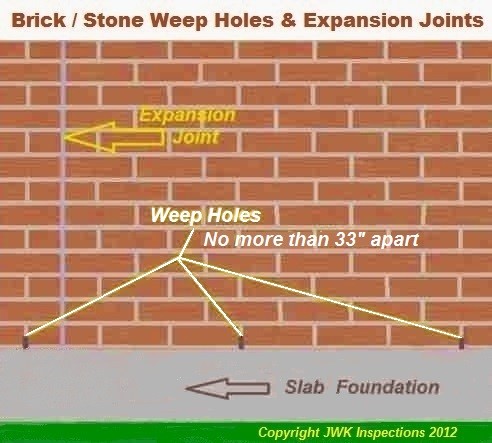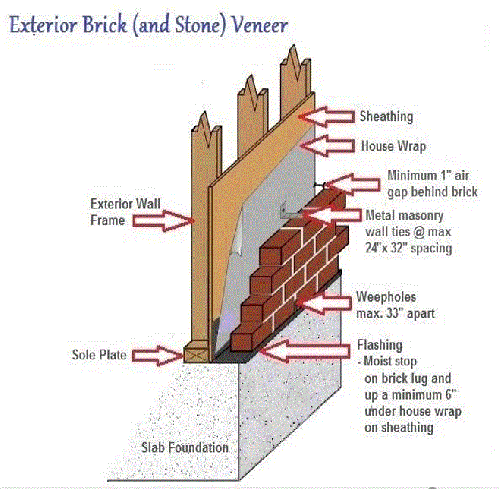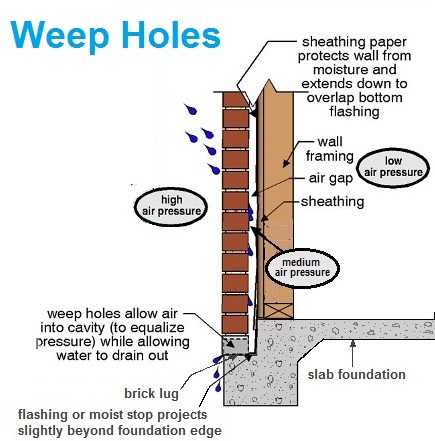JoeKeresztury's blog
Masonry Weep Holes
Submitted by JoeKeresztury on Fri, 06/01/2012 - 00:30.Weep Holes Are Needed For Your San Antonio Area Home

Weep holes are the needed and required openings in the bottom of the exterior stone or brick masonry walls of your home which allow any unwanted moisture to drain out down the drainage plane of the required minimum 1" air gap area behind the masonry ensuring that moisture and related problems cannot accumulate behind the masonry walls in conjunction to proper moisture seal on the exterior wall sheathing (house wrap). The air circulation created by weep holes and the required air gap between the masonry walls and structure help prevent the possibility of molds which can cause many problems to a home assuming there is a decent sheathing and / or house wrap. Weep holes should be present on masonry areas at the foundation of brick and stone veneer homes, while homes with stucco should have a drip screed. All of these masonry situations are prone to water penetrations that will cause problems if they are not constructed and maintained properly. 
 This image shows a cross section of Brick Installation. The weep holes are ordinarily installed in the masonry during the construction process when the masons are laying the brick or stone veneer on the brick lug (ledge) of the slab foundation. A stone or brick veneer while not actually a structural component of the home is attached to the structure though, this being to the exterior wall frame of the home or building with galvanized wall ties at no more than a 2' x 2' staggered pattern.
This image shows a cross section of Brick Installation. The weep holes are ordinarily installed in the masonry during the construction process when the masons are laying the brick or stone veneer on the brick lug (ledge) of the slab foundation. A stone or brick veneer while not actually a structural component of the home is attached to the structure though, this being to the exterior wall frame of the home or building with galvanized wall ties at no more than a 2' x 2' staggered pattern.
Wall ties at masonry installed properly help with movement that may cause cracking in the masonry and/ or the joints that could cause moisture intrusion, this along with needed expansion joints at required intervals being properly sealed will help cut down on unneeded moisture penetrations into the air gap between the masonry veneer and the structural exterior wall that hopefully has a proper house wrap or sheathing situation in place.
Required weep holes are made by leaving openings in the mortar joints between the stone or brick at the area that sits on the foundation. The brick lug of a slab foundation is dropped 1-1/2" from the main level of the slab which also helps with any water penetration issues behind the masonry wall since it is lowered. Weep holes are required to be no further than 33" apart and the opening must be at least a diameter in size of 3/16 of an inch.
Weep holes need to be above grade. If not then, water, dirt and debris can enter the walls through them and even worse, clog the weep holes. Weep holes should be at the top of slab level and at the very bottom of the masonry level. Brick and stone (all masonry) is required to be at least 4" above grade which leaves plenty of room for the weep hole venting and drainage.
Weep holes should also be present above windows, exterior doors and garage overhead doors at brick or stone areas.
While house wraps, sheathing, flashing. etc. are designed to prevent water penetration into homes, it isn't always successful. Without weep holes and the air gap between a brick/stone veneer and the structure water which gets through penetrations such as cracks and gaps will be trapped in the walls, where it may lead to mildew, mold, rot, and an invitation to termites and other issues. The ventilation of the air gap thru the weep holes and any needed drainage thru the weep holes will help prevent this.
By Joe Keresztury, JWK Inspections.
San Antonio Home Inspector and New Home Construction Specialist




















